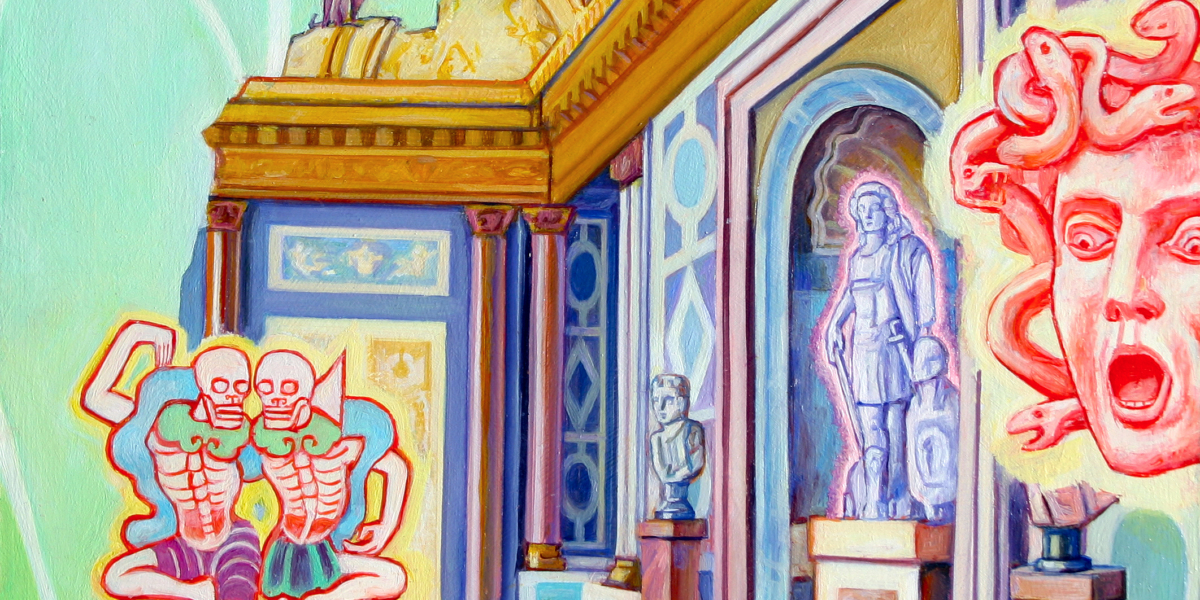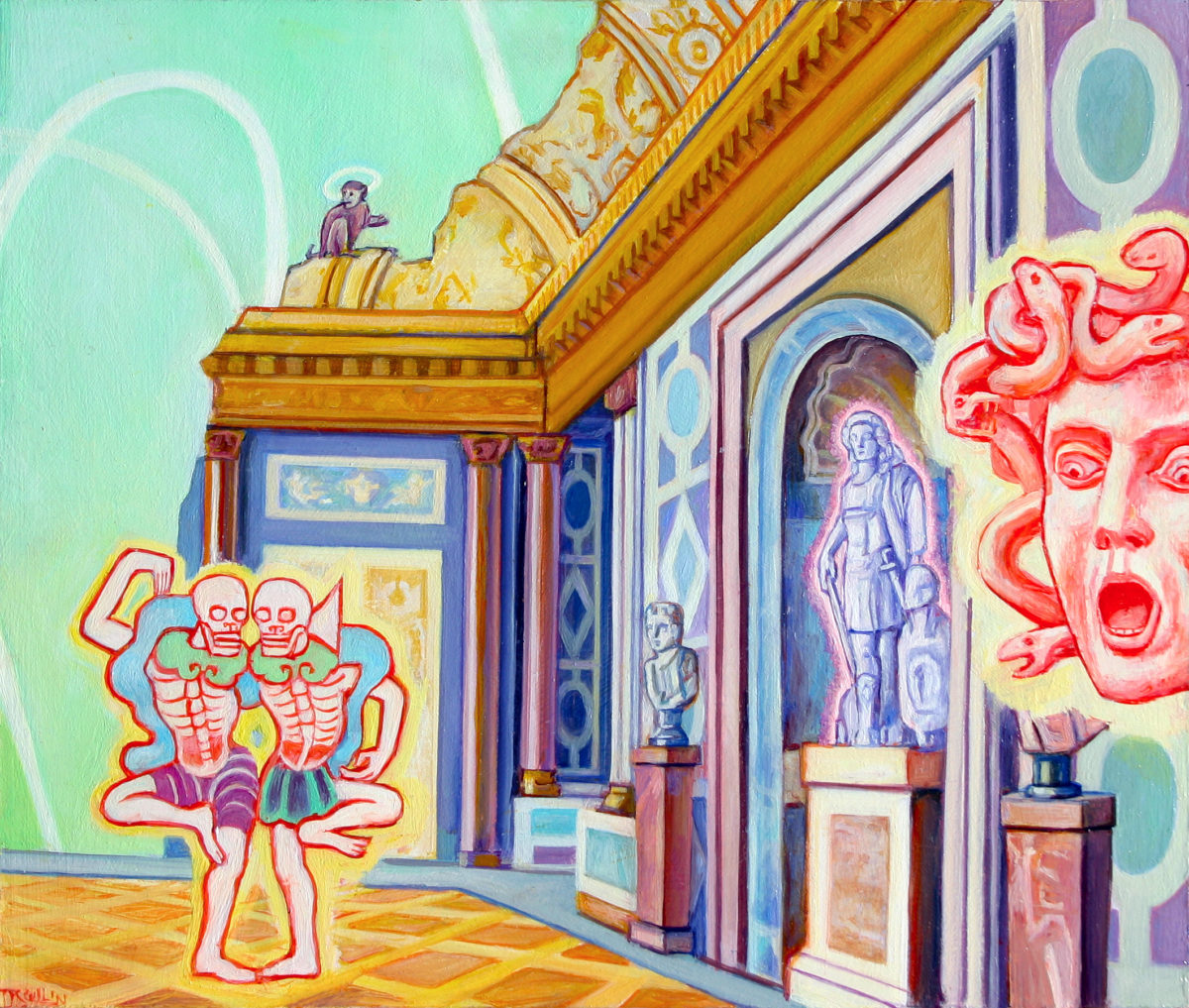
New retrospective opening April 8 honors PCA&D co-founder Tom Scullin
Thursday, March 31st, 2022
The impact of Tom Scullin’s art career isn’t just seen in his prolific output of painting, or the books he’s authored, or the hundreds upon hundreds of students he taught during nearly four decades in higher education.
If his impact was confined just to that list, it would be remarkable enough. But, it could be argued, it’s all of that and one more major contribution:
If it weren’t for Tom Scullin, Pennsylvania College of Art & Design may not exist as it does today.
As one of the school’s founders in 1982, and as the final original faculty member to retire from the College, Scullin’s influence runs deep. So it’s only fitting that The Gallery at PCA&D pay tribute to Scullin with an overview of the artist’s work.
Tom Scullin: Retrospective of Paintings opens Friday, April 8 in the main gallery and runs through Sunday, May 8.
“There can be no better tribute to an artist than to showcase their work in a retrospective,” said Alex Schaufele, Pennsylvania College of Art & Design Director of Exhibitions. “This particular retrospective is all the more exciting because Tom is considered one of the founding members of Pennsylvania College of Art & Design. The opportunity to have a deep history of his work in a place where he taught for so many years is an honor for us and, I hope, for him.”
His PCA&D foundations
Scullin may have devoted his life to the arts, but that’s not necessarily where he saw his future as a child or teenager. One of nine children in his family, Scullin began his undergraduate college career in the sciences “and was pretty well set on it,” he said in an interview at his Lancaster home. “But I didn’t know what I was doing, really — I was good at taking tests. Being precise was not my methodology.” Scullin’s brother, studying at the same time, went into printmaking and art history, and Scullin himself soon made the switch to painting. His art school instructors and peers who were much more into color field painters (think abstract, such as Mark Rothko), he said, but Scullin took another route. “I’ve always been a realist, to some degree,” he said. “I’m a contrarian.”
After earning his BFA from The Ohio State University, Scullin went on to earn an MFA from Penn State and, soon afterward, attend the Skowhegan School of Sculpture and Painting in New York.
It was in 1982, 40 years ago, that Scullin and a small group of artists founded the diploma-granting Pennsylvania School of the Arts in Marietta, Lancaster County. Over the years it’s transformed, to an associate’s degree-granting Pennsylvania School of Art & Design and, finally, to the BFA-granting College it is today. Through it all, Scullin was one of those laying the foundation, building its purpose, and keeping the lights on — sometimes literally.
He never served as the school’s president, but he filled nearly every other role during his tenure. He not only taught first-year Foundation classes from 1982 to 2017, he wrote much of the curriculum. He contributed to standardizing the Foundation Drawing and 2D curriculum. He served as Assistant Dean of Administration, Head of Facilities, and Foundation Department Chair, and would contribute his insight as a member of the Board of Trustees.
It’s as an instructor, though, that he had his greatest direct impact on students. “I always thought I had to be engaged as a teacher” to be effective, he said. “Normally I’d do the project as they did it, as a demo, kind of a show and tell, and put myself out there.”
It’s also as an instructor where he encouraged his students to think more deeply, not only about their own art but about the work of others. While teaching Art History, he said by way of example, “I had to convey that it’s not just about the painting or the art itself. Who was paying (for the work to be done)? What was the culture? You need to look at the geopolitical and social issues of the time” to truly understand a work’s impact, purpose, and deeper meanings.

“Versailles Dance of Death,” Tom Scullin, 2022.
‘Eventually it all fits and floats’
Scullin also applies that search for deeper meaning in his own work. Buried in his realist paintings often are allegories that reference grand themes: Mystery. Death. Morality. “I’ve always dealt with the catastrophic to some extent,” Scullin said.
“Now my subjects are a Hyper-Baroque mix of puzzling juxtapositions,” Scullin writes on his website. “The Baroque is my favorite historical era. The dynamism of exploitative exploration and the hysteria of religious intolerance are its hallmarks. Allegorical paintings should be infused with a contextual richness that extends across many categories of time, cultures, and morality.”
Those themes are often paired with a carefully chosen palette of brilliant color and bold lighting. Together, he uses the combination “to record visual phenomena that haven’t been captured before; to really record what we see” and how we see it.
Perspective also factors strongly into his work. “You get a feeling for puzzle-solving,” he said. “It’s kind of like crafting a boat: Eventually it all fits and floats.”
Schaufele said Scullin’s work rewards extended or repeated viewing.
“The first thing you notice about Tom’s work is that there is always more than meets the eye,” Schaufele said. “His explorations of physical and cultural perspectives over the years layer together to create a rich visual story in every work.”
The artist may be retired from teaching, but he is far from “retired” from his artwork. It fills every inch of his Lancaster home studio, the walls of his home, the basement storage area for his larger works. He still prefers to work on multiple pieces at once, he said — not only because “they bounce off each other,” but also because “it’s very important to get away (from a particular piece) for a few days at a time.
“You think you know what it looks like, but you need that separation. Then you’re not afraid of making changes.”
Sometimes that separation takes the form of working in a different medium: writing. His most recent work, Writings for Short Attention Spans, is a collection of, appropriately enough, very short stories and poems (described on its Amazon page as “the pith without the pulp”). It opens with a poetic tribute to Zelda, his beloved late wife.
He may be crafting with words instead of paints, but Scullin still sees similarities.
“I take a premise and try to flip it to get a chain reaction going,” he said.
Schaufele is excited to put the result of those “chain reactions” on the gallery walls. Curating the exhibition, she said, was a true collaboration.
“He pulled a wide sampling of pieces he considered excellent samples of different phases of his artistic style,” Schaufele said. “I then listened to him speak about the works, looked at them myself, and began whittling down the options with him to have a good representation of each period.
“In the end, I think that the full story of Tom’s career up to today has been told and there are many opportunities for guests to explore a new perspective.”
You can see more of Tom Scullin’s work at tomscullin.com.
